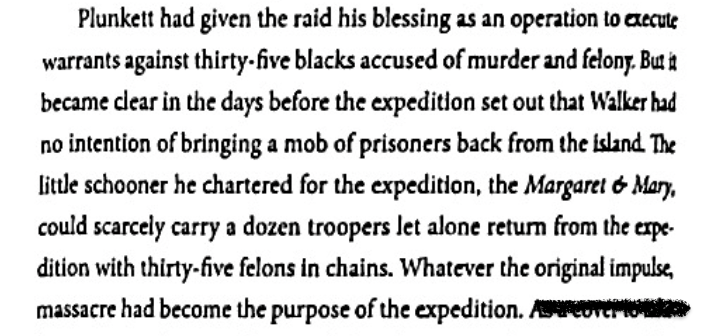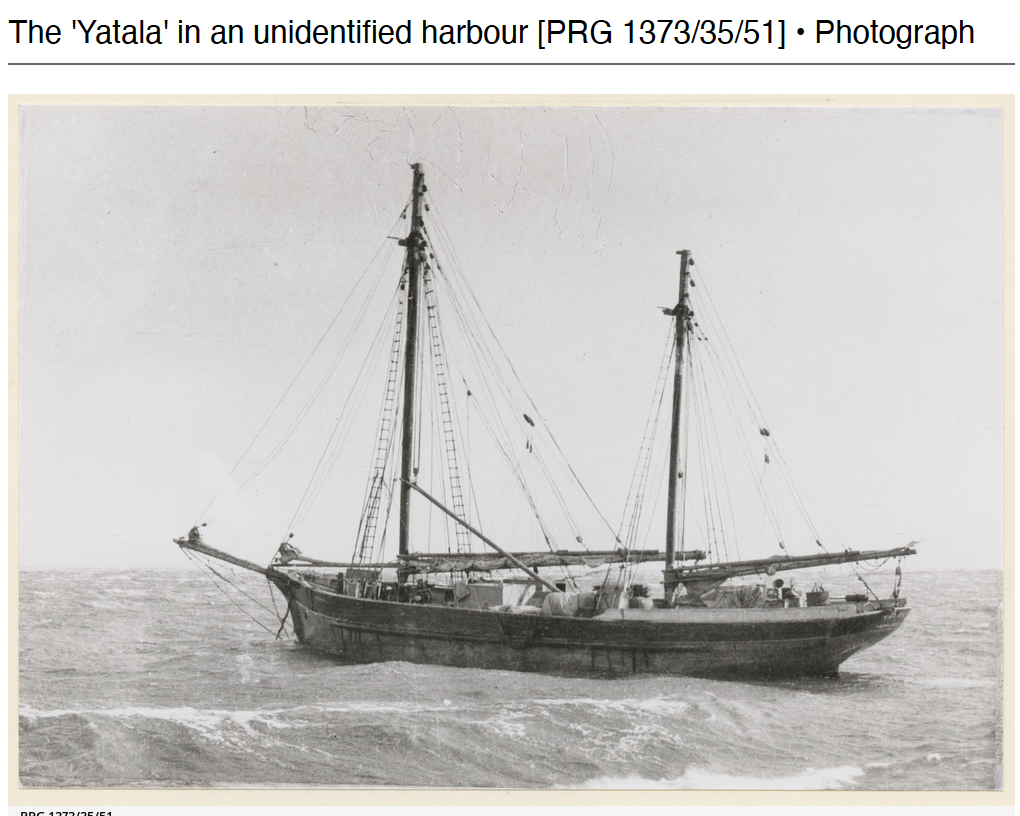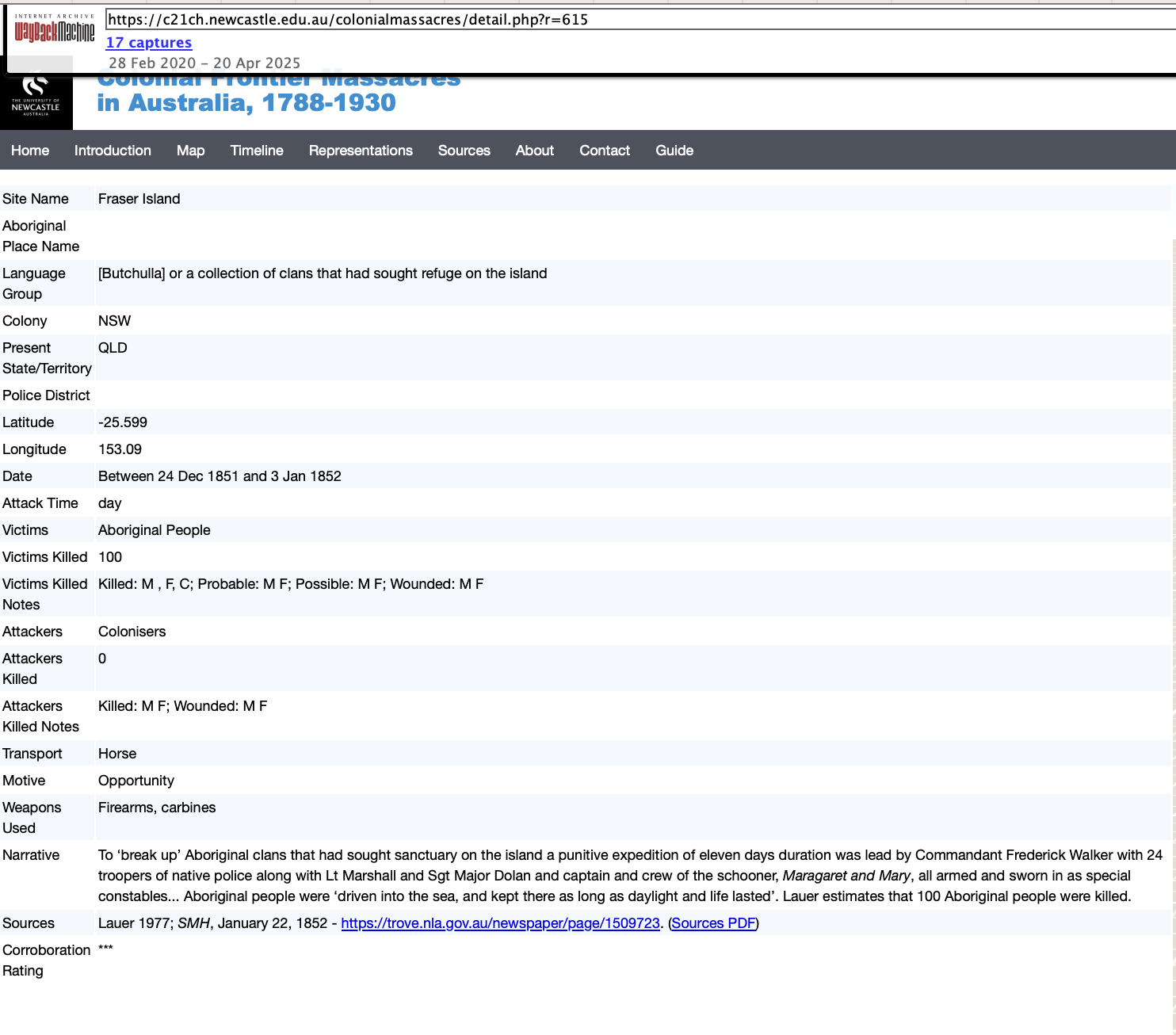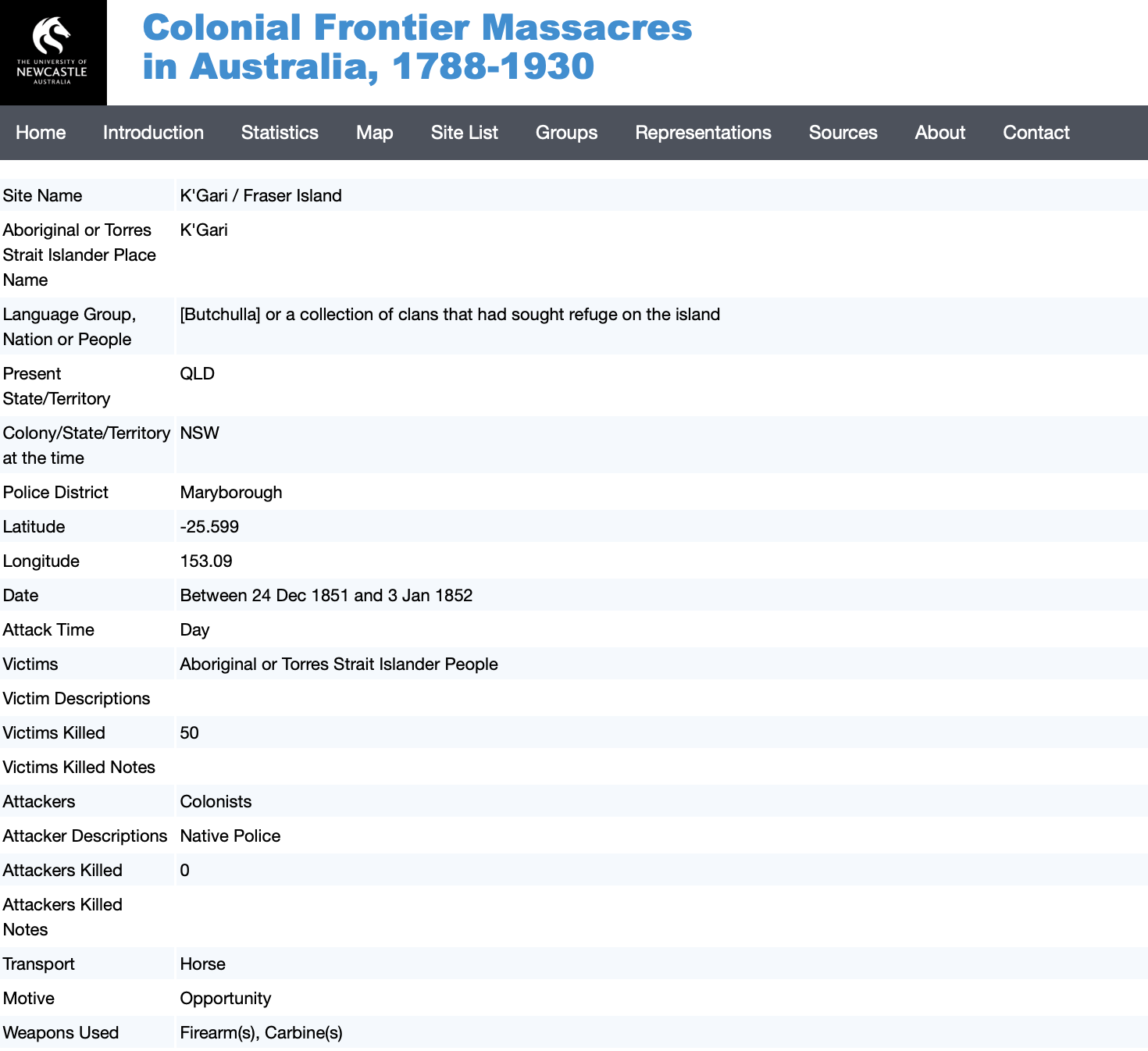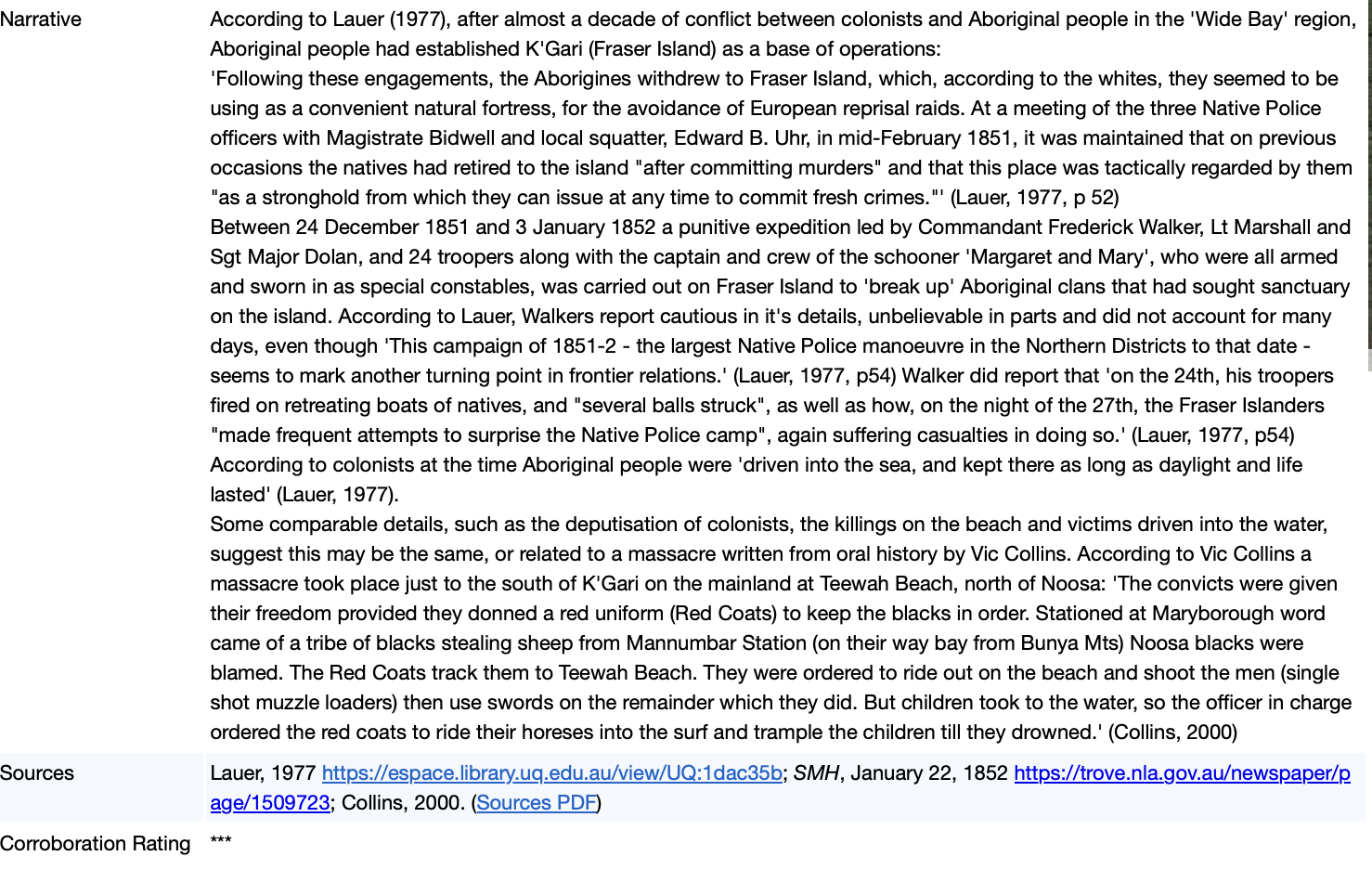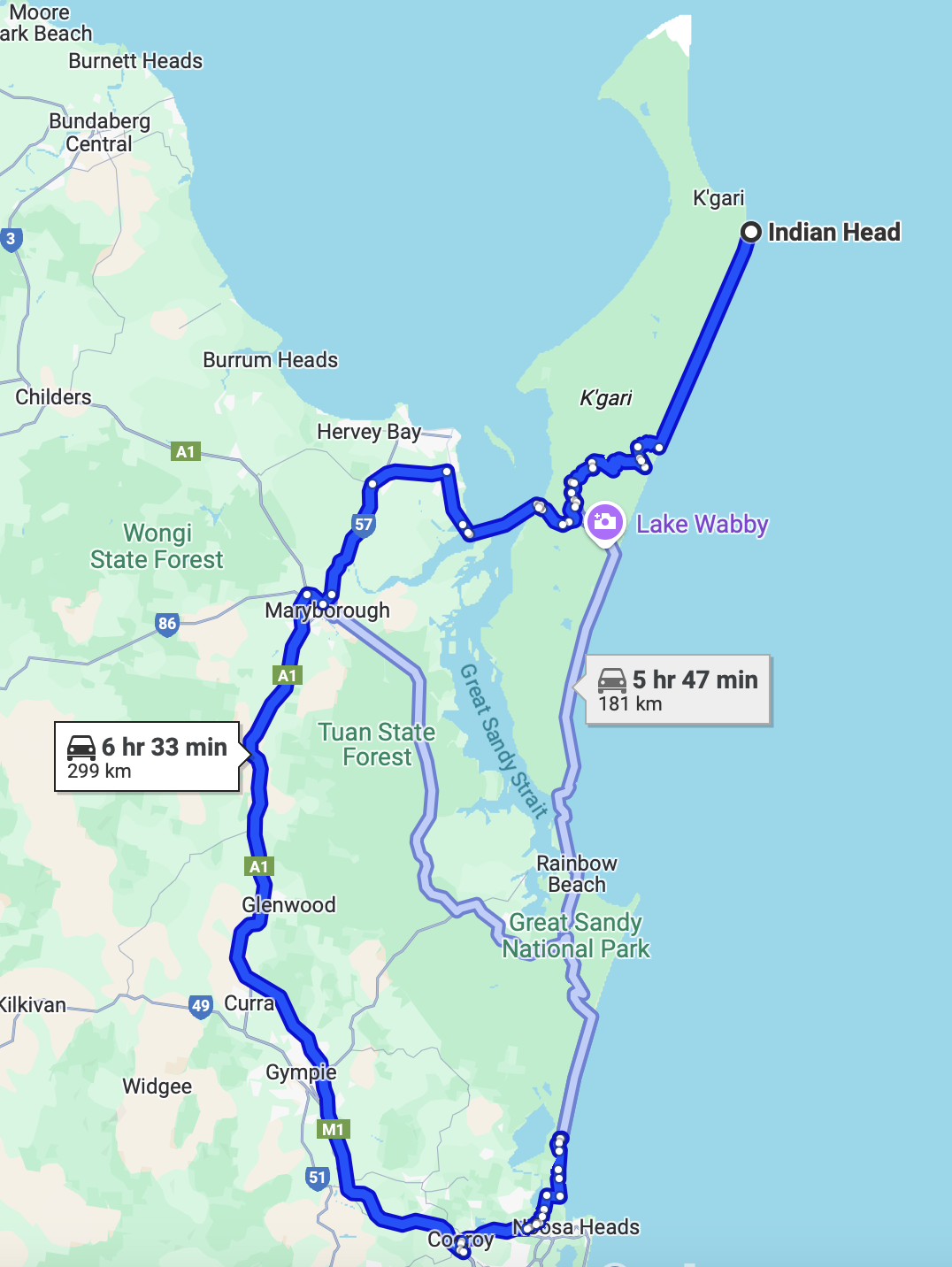David Marr Pays the Ferryman - Crossing over to Fabrication Island
This post goes to the heart of journalistic ethics - is it morally right as a journalist to knock on the door of a family and tell them that their ancestors were ‘massacred’ when you know the evidence is tenuous hearsay at best, or a deliberately scurrilous fabrication against the alleged murderers at worst?
David Marr, a highly educated, intelligent and deep-thinking journalist and lawyer has found himself in such a dilemma. His clinched fist has been metaphorically poised at the doors of all the Aboriginal Butchulla families in Queensland, a copy of his investigative, family narrative, Killing for Country, under his arm. Does he knock and gain fame and book sales but, by necessity, condemn these families to forever carry the burden of inter-generational grief for mythical murders most foul? Or does he hold back, remembering his lawyer’s code on hearsay, and decide that breathing life into the sleeping dogs of historical rumours is no way for an ethical man to behave?
History records that Marr opened his book to page 200 and knocked.
The Fabrication of the Fraser Island ‘Massacre’
The truth is simple and grim: the Commandant [Frederick Walker] was allowing on a vast scale what officers of the force were used to doing by this time: sitting outside scrubs as their troopers killed out of sight…According to rumours then and traditional owners now, there was a massacre on the beach at this time, probably at Takky Wooroo (Indian Head).
“A lot of our people were killed there,” a traditional owner told a 2017 investigation into the heritage significance of the site. Another said: “All’s I know is about the massacre and I know that it was true; its true! It is! It’s true; it was handed down.” Walker and his men were so tight-lipped after the raid that suspicions were immediately aroused that something terrible had happened out there.
- David Marr, Killing for Country, p200-1 [see Marr’s full paragraphs here, & discussion below)
That is the basic summary of Marr’s evidence for the massacre - a so-called tight-lipped Commandant and his “scrappy report” with something to hide, plus hearsay, oral history and rumours 170 years later from people who weren’t there. Very unwisely, Marr also offers one of his own deductions as evidence that the massacre occurred. Marr claims that when Walker sailed out to Fraser Island he had chartered too small a boat on purpose because he had no intention of returning with any of the alleged Aboriginal felons and murderers who might be arrested. Marr claims the “little schooner” was so small that it could not have accommodated Walker, his half-dozen white officers and special constables, and his 24 troops, plus a “mob of prisoners” on the return trip. Therefore, Marr concludes, “Walker had no intention of bringing a mob of prisoners back” and thus speculates that “massacre had become the purpose of the expedition.”
Today’s ‘official’ massacre web-sites, such as University of Newcastle’s, Colonial Massacre Map, and the Guardian’s, Killing Times, embellish the story further by claiming the numbers ‘massacred’ were 50 or 100 Aboriginal people [See Further Reading 3 below on the sources for this alleged death toll].
Excerpts from Marr’s book tell the story, starting with the expedition receiving the “blessing” of the Attorney-General John Plunkett:
Figure 1 - Source: David Marr (Killing for Country, 2023) p196
I contend that Marr’s reasoning is delusional for the following reasons.
A) The schooner Margaret and Mary was not “little.”
A report issued when the schooner was built in 1851 states that it was “about 125 tons” and of “length, 79 feet” (24m) (Figure 2).
Figure 2 - Shipping news notice for the delivery of the 79 ft (24m) schooner Margaret and Mary, chartered by Walker for the Fraser Island expedition. Source: Ships in Harbour, The Shipping Gazette and Sydney General Trade List, Sat 21 June 1851, p181, [Trove]
The Margaret and Mary was wrecked in 1871 and its dimensions are now recorded as being 77 tons and of 22m in length (see Figures 3 and 4). The differences in reported tonnage may be due to the 1851 gazette report being actually just an estimate (“about”). Nevertheless, for the purposes of this post we will assume the smallest possible dimensions for the Margaret and Mary - that she was a 77 ton, 22 to 24m, two-masted schooner [by definition schooners have at least two masts].
Figure 3 - Details of the Margaret and Mary wreck from a popluar wreck site database. Source
Figure 4 - Details of the Margaret and Mary wreck from the NSW Office of Environment and Heritage wreck site database. Source
No photograph of the actual Margaret and Mary could be found, but an image of another equivalent, the 77 ton and 24m schooner, the Cygnet is available (Figure 5 ). Additionally, a photograph of another similar, two-masted ketch, the 77 ton and 24m Yatala, is available for comparison (Figure 6).
Figure 5 - The wooden schooner, Cygnet, built in 1875 at 77 tons and 79 ft (24m long) is a good proxy for the Margaret and Mary. Readers can make up their own minds as to whether they believe that a ship such as this is a “little schooner” and was, as David Marr assures us, incapable of carrying half a dozen white officers and special constables, 24 native police and up to 35 Aboriginal prisoners….and a horse. Source: file
Figure 6 - Similarly for comparative purposes is the Yatala, a wooden ketch of the same specifications as the Margaret and Mary - 77 tons and 79 ft (24m long). Readers can make up their own minds as to whether they believe that a ship of these dimensions could carry the half a dozen white officers and special constables, 24 Native police and up to 35 Aboriginal prisoners, and a horse, that the return trip from Fraser Island might have entailed. Source: file
What these images of the Cygnet and the Yatala indicate is that Marr’s reasoning doesn’t stand up to scrutiny if he thinks that Walker’s choice of the 77 ton Margaret and Mary was done because there would be insufficient stowage to accomodate up to 35 Aboriginal prisoners, along with his troops, on the return voyage from Fraser Island. A 77 ton, 24m schooner is clearly a relatively large coastal vessel, more than capable of accomodating on deck and below, up to 65 people - and a horse.
Marr’s speculation that Walker’s sole motive for the expedition was massacre, because he chose a “little schooner”, is clearly unsubstantiated.
Furthermore, a few pages on, Marr completely contradicts his own theory by admitting that Walker actually had more than vessel !
The expedition in fact consisted of what Marr himself describes as a “convoy” (Figure 7) or a “flotilla” (Figure 8) of vessels.
Figure 7 - An paragraph from Marr’s book that contradicts his speculation that Walker chose the Margaret and Mary, a “little schooner”, on purpose so as not to be able to accomodate the Aboriginal prisoners. But here Marr admits that there was a “convoy” - the Margaret and Mary plus two other boats. Wouldn’t this be more than enough to accommodate up to 35 Aboriginal prisoners? Source: David Marr (Killing for Country, 2023) p198
Marr’s theory is further compromised when he admits Walker’s men captured the dinghy being used by the Aborigines who had presumably used it to flee to Fraser Island from the mainland. This was a fourth vessel that made the return trip to the Queensland mainland. It appears that there would be more than enough space in the now four vessels to accommodate any arrested Aborigines (Figure 8).
Figure 8 - Source: David Marr (Killing for Country, 2023) p199
B) Hearsay and Oral History is not Evidence in Murder Accusations
Very surprisingly, David Marr, a qualified lawyer, openly admits that he is relying on “rumour” at the time, and oral history of “traditional owners now” to support his claim that Walker and his Native Police carried out a massacre on Fraser Island. Tellingly, no one seems to know exactly where this massacre was supposed to have occurred - Marr states it was “probably” at Takky Wooroo (Figures 9A&B)
If Marr believes the evidence is compelling why is it that no one knows for certain where the massacre site even was? Why, as far as I am aware, hasn’t anyone ever located skeletons or other evidence for a massacre of 50 or 100 people? That is a huge number of victims so archeological evidence such as bones, bullets and damaged weapons would be expected to have been found at the site (see Why Isn’t There Evidence for Frontier Wars?).
Figures 9A&B - Marr, a qualified lawyer, admits his ‘massacre’ narrative is based on “rumour” and oral history. This is not the primary evidence historians rely upon - it is not the way history is done. Source: David Marr (Killing for Country, 2023) p200-1
C) Marr’s Use of Selective Quotations
To create a sense that Walker was being secretive, Marr selectively quotes one line out of a 'Letter to the Editor’, sent to a newspaper some six months after the events, by an anonymous contributor:
“So much secrecy really makes the whole matter look bad,” Vox told The Sydney Morning Herald (Figure 9B)
The full ‘Letter’ however indicates that “Vox” had not much to contribute to the discussion except as an illustration of his/her frustration for being left out of the gossip loop given their self-appointed importance as being “a near resident and one of the oldest inhabitants in these parts” [the local, elderly busy-body perhaps?] (Figure 10). In reality, the Letter has about as much historiographical value as an anonymous Facebook post would have today from a self-riteous, key-board warrior, critical of a police operation.
Figure 10 - The full ‘Letter to the Editor’ published some six months after the events and selectively quoted by Marr to lead his readers to believe that Walker’s expedition was a great secret.
Note the author is anonymous, [“VOX”], he/she admits on one point “I forget which” and he may be getting his Aboriginal prisoners mixed up (The two blackfellows in the lockup may have been the two arrested on Fraser Island). He obviously doesn’t know for “what purposes they [the Native Police] were sent there”, but then we might ask why should he? Who is he/she such that they are entitled to know what is going on regarding the details of a police operation? “VOX” just comes across as a nosey local who has been kept out of the loop of official police business. Source: said to be The Sydney Morning Herald 12 June 1852, supplement, p2.
D) David Marr, the “putatively educated lay person” Succumbs to Presentism
In a 2017 Quadrant magazine article, Dr John Moses, Professorial Associate of St Mark’s National Theological Centre in Canberra was, to my mind, anticipating the history writing methodology adopted by the author of Killing for Country:
Reliable historians try, as far as humanly possible, to re-experience the past through the eyes of the people living at that time. That should have been a methodological tool every student acquired when studying first-year history at university.
So instead of getting informed and dispassionate accounts of the past, one is presented with often angry, ill-informed diatribes which say, in effect, that is not how it should have been. If this attitude is rife among professional historians and teachers, it is doubtless even more widespread among putatively educated lay persons…It behoves historians and other writers who venture to instruct their fellow countrymen and women to re-calibrate intellectually and to find out the facts before rushing into print with their “presentist” preconceived notions.
David Marr is a “presentist” because Killing for Country is a book of history clearly written by an author looking through a thick lens of anti-white, anti-colonial glass. Marr wants to delegitimise the legal basis on which Australia was settled and to do that he needs to unsettle the minds of the Australians today. That is why he admits to being “a huge admirer of Henry Reynolds” who is the purveyor of the “Original Sin” thesis in the settlement of Australia (See Marr and Reynolds here).
Both Marr and Reynolds want modern Australians to carry the blame and make amends for a history created by our ancestors - “we” need to atone for the “Original Sin” of the deaths of any Aborigines on the frontier because, according to Marr and Reynolds, “that is not how it should have been.”
E) What Would John Hirst Say?
During his long career, the late Australian historian John Hirst [1942-2016] had thought deeply about the lament of the “savagery” that David Marr voices today in Killing for Country:
“…Journalists were the most persistent voices. But lawyers, missionaries, stockmen, a few magistrates, and a cohort of decent squatters also argued from the start that the conquest of this country, though inevitable, did not need to be so savage - the most brutal colonial invasion in the nineteenth-century Empire. So many were slaughtered. Kidnapping never ceased. Every acre was taken. None of the huge wealth earned on their country flowed back to its original owners. Laws counted for nothing. No treaties were made. And when the fighting was over, we set about forgetting how Australia was won.”
- David Marr (ibid., p410)
If Hirst was reviewing Killing for Country he might have tried to bring a delusional Marr back to earth by offering a couple of insights. First, he might have sent Marr the opening paragraphs from a chapter in his own 2006 book, Sense & Nonsense in Australian History, coincidently by the same publisher as Marr’s, Blackinc (Figure 11A).
Figure 11A - Excerpt from the chapter, How Sorry Can We Be?, from John Hirst’s, Sense & Nonsense in Australian History, Blackinc, 2006.
In essence Marr only exists today as a virtue-signally critic of his ancestors, the “murderous” Uhr’s, because of the deeds of those same Uhr brothers. No Uhr brothers and their deeds in the settlement of Australia, No David Marr.
Second, Hirst might have sent Marr the following extract from the same chapter in which he expands on the “liberal fantasy view” of Australia’s origins. The paragraphs start with a “liberal fantasy” response from an audience member at a 2003 debate in Melbourne between historian Keith Windschuttle and his critic Robert Manne. Hirst was in the chair, and the argument was about the numbers of Aborigines allegedly killed in the so-called ‘Frontier Wars’ and the legal basis of Australia’s settlement:
Figures 11A&C - Extract from the chapter How Sorry Can We Be? in John Hirst’s, Sense & Nonsense in Australian History, Blackinc, 2006, p82-3
Hirst also provides comment on historian Henry Reynolds’ tendency to the “liberal fantasy” view:
Figures 12 - Extract from the chapter How Sorry Can We Be? in John Hirst’s, Sense & Nonsense in Australian History, Blackinc, 2006, p84
F) The Hypocrisy of David Marr’s Thinking
Besides Marr’s, 'what should have been’ type of thinking being an anachronistic, “liberal fantasy”, isn’t it also a little hypocritical?
In the context of the times, Frederick Walker was carrying out a legally sanctioned police operation. Queensland author and retired lawyer, Paul Dillon, has provided an excellent summary of the legal basis of Walker’s Fraser Island expedition [see Further Reading 1 below].
Dillon notes that two of the Aboriginal suspects were arrested, transferred to court where the case against them was dismissed due to lack of evidence and they were set free. This outcome is further evidence that Marr’s theory that a massacre was planned all along was nonsense - why would Walker take two prisoners alive if his intent was solely massacre? It is also evidence that a British/Australian colonial justice was in operation where the Aborigines weren’t lynched (as they might have been in the US), imprisoned without trial (as they might have been in Africa or the Middle East) or murdered (as Aboriginal custom might have demanded as ‘payback’) but they were given the same due process as any other British subject in the colony at that time.
In a speech at a dinner in 2010 in support of World Day Against the Death Penalty, David Marr told the assembled guests:
I admire and I’m moved by those who argue against the death penalty on the pure ground of its savagery. Executions are cold blooded acts of violence that diminish all who live in those states that carry them out.
- [World Day Against the Death Penalty dinner, 8 Oct 2010]
But in the hypocritical world inhabited by the Progressive Left, self-righteous commentators like David Marr willingly point the finger at modern execution States, such as Singapore for drug-trafficking, or at alleged historical executioners, like policeman Frederick Walker, without any self-reflection on themselves or their own political party or society. Marr thinks that he lives in a ‘state’ that is ‘undiminished by executions, the cold blooded acts of violence.’
But is that really true?
Our society, like David Marr, pat’s itself on the back for abolishing the death penalty in the 1960s when in reality we have just hand-balled this enormous responsibilty to our policemen and women. In the following film clip, we see a Victorian policeman, forced in a matter of seconds to become on our behalf, judge, jury and executioner, shoot dead and in cold blood, a man attacking him and others with a knife. David Marr is strangely silent on this killing [googling “Hassan Khalif Shire Ali” + “David Marr” brought no hits] yet he excoriates the legacy of Frederick Walker for doing the same 170 years ago [“2 blacks killed” while trying to surprise our camp. See Figure 14B, point 9]. Why the double-standard by Marr?
David Marr’s silence on another Aboriginal massacre from Queensland is even more telling.
It involves an Aboriginal man from NSW being pursued by police across the border into Queensland. The man had broken his restrictive residency permit and he was also believed to be carrying illegal firearms. The Queensland police took up the case and tracked him back to his family’s camp in remote Queensland. A confrontation ensued, two police and an assisting settler were killed. A police reprisal party was rapidly organised and three members of the Aboriginal family were killed (executed). In all, six people lay dead - a ‘massacre’ by the definition of the University of Newcastle’s Colonial Massacre Map. Yet not a word about this well known massacre appears in Marr’s book, or even on the Colonial Massacre Map itself. How so?
The reason is that this tragic massacre occurred in 2022 in the modern state of Queensland under a Labor government - the event is more commonly known as the Wieambilla Shootings. What is known, but has certainly not been acknowledged publicly by the Queensland Government, their police force, the Guardian’s Deaths in Custody database, the University of Newcastle’s Colonial Massacre Map and indeed journalists who write books about Aboriginal massacres, like David Marr, is that the male perpetrators were Aboriginal men.
One can only speculate as to the reasoning, but it would appear that this killing of Aboriginal men doesn’t suit the narrative of the Progressive Left and so the Aboriginality of two of the victims has been downplayed. Again, a search of Google indicates that David Marr is silent on this Aboriginal massacre.
Summary
David Marr’s Killing for Country is sad indictment of where our country finds itself today - a man who clearly has a strong intellect undertakes (wastes?) five years of hard work to produce nothing more that an ideological polemic, full of misquotes, errors and fabrications that adds nothing much to further our understanding our colonial history. Marr’s book should have been a slimmer volume and potentially more valuable by focusing only on his ancestors and their place in our country’s history, a fair enough endeavour.
Despite the commendable job Marr’s partner, Sebastian Tesoriero, has done in digging out many primary sources, his effort is compromised by Marr’s use of selective quotation and mis-interpretation of those sources. History enthusiasts like myself are grateful for Tesoriero’s extensive list of citations and references to add to our own databases, but my advice nevertheless is for interested readers of history to assign Killing for Country to the literary dustbin and instead for them to purchase the range of Paul Dillon’s books, and a subscription to Quadrant magazine, where they will find hundreds of articles on Australia’s true Aboriginal and colonial history.
Roger Karge, Editor, Dark Emu Exposed and a member of the ‘Quadrant Crowd.”
15 May 2025
Further Reading 1.
1.1 - Lawyer and Author Paul Dillon’s Summary of Frederick Walker’s Fraser Island Expedition 1851/2 (Figures 13A&B)
Figures 13A&B - A summary of the legal framework, justification and outcome of Frederick Walker’s Fraser Island Expedition with his Native Police during 1851 to 1852. Source: Dillon (Fraser ISalnd massacre, 2022, p93-4)
Further Reading 2.
2.1 - Final Report by Commandant Frederick Walker on the Native Police Expedition to Fraser Island, 24 December 1851 to 3 January 1852.
Figures 14A,B&C - Transcript of Frederick Walker’s final report on the Fraser Island expedition.
Note that the official confirmed death toll of “2 blacks killed” after the blacks made frequent attempts to surprise [attack] the Native Police camp. There may have been other blacks killed in their escaping boat when “ the police fired into it and several balls struck”, (see point 8) but there is no recorded of any further number killed.
Source: Excerpt of transcription by Dillon (Fraser Island Massacre, 2022), p212-4. Original file at QSL Reel A2.23, p820-30, pdf file here
Further Reading 3
Two ‘orthodox’ academic entries for the alleged Fraser Island massacre have been published - one on the University of Newcastle’s Colonial Massacre Map and one on the Guardian’s Killing Times website [based on data derived from the University of Newcastle].
The Colonial Massacre Map had recorded a death toll of 100 Aboriginal victims in its 2022 edition (Figure 15)
Figure 15 - Summary of the alleged 1851/2 Fraser Island ‘massacre’ as recorded on University of Newcastle’s Colonial Massacre Map alleging 100 Aboriginal victims. Source: Wayback Machine March 2022
However, by May 2025 the Colonial Massacre Map (as well as the Guardian Killing Times) had been amended with the victim death toll inexplicably reduced to “50 Aboriginal or Torres Strait islander People”. (Figures 16A & B and 17).
Readers will note that none of the three references cited seem to mention the deaths of “100” or even “50” Aborigines. Like many other entries in the Colonial Massacre Map these death tolls seem to be ‘just made up’ (see Figures 18, 19 &20).
This practice of just “making up figures” was readily admitted to by the architect of Colonial Massacre Map, the late Professor Lyndall Ryan, as confirmed in the following film clip.
Figure 16A - Summary of the alleged 1851/2 Fraser Island ‘massacre’ as recorded on University of Newcastle’s Colonial Massacre Map now alleging 50 Aboriginal victims. Source:
Figure 16B - Narrative for Figure 16A - University of Newcastle Colonial Massacre Map for Fraser Island ‘massacre’ . No reference to the official 1852 report of Comandant Frederick walker is made where the official death toll at the time was “2 blacks killed” and an unknown number additional number killed or wounded when “ the police fired into it [an escaping boat] and several balls struck.” Source:
Figure 17 - The Guardian’s Killing Times entry for the so-called Fraser Island massacre is based on the University of Newcastle’s Colonial Massacre Map (Figures 16A&B above)
Readers are requested to check the following three citations to see if they can find the evidence for, or even the mention of, a death toll of “50” or “100” as the University of Newcastle claims - I could find none.
Citation 1 - Lauer (1977)
Figure 18- The University of Newcastle Colonial Massacre Map citation is “Lauer 1977” by which they mean the paper "These strangers, where are they going?'-ABORIGINAL-EUROPEAN RELATIONS IN THE FRASER ISLAND AND WIDE BAY REGION 1770-1905, by Raymond Evans and Jan Walker, on pages 39ff.
Evans and Walker do not mention a numerical death toll from Walker’s expedition to Fraser Island. Source: Lauer (1977)
Citation 2 - SMH 1852
Figure 19 - No mention of a death toll of “50” or “100” in The Sydney Morning Herald , Thu 22 Jan 1852, citation, Page 2. Source:
Citation 3 - Collins (2000)
This appears to be an unrelated citation. It refers to an alleged massacre in the late 1800s, not on Fraser Island but on the Queensland mainland, at Teewah Beach, which is some 180km south of where the Native Police massacre is alleged to have occurred at Indian Head on Fraser Island.
Figure 20A - John Oxley Library catalogue entry for “Collins (2000)”. Source for Library reference. Actual item below in Figure 20B
Figure 20B - Reference “Collins (2000)” relied upon by University of Newcastle’s Colonial Massacre Map to support their claim that “50 Aboriginal and Torres Strait Islander people” were killed in a so-called massacre at Indian Head on Fraser Island. Readers will clearly see that this letter - written by a Vic Collins in 2000, who claims his dad Bill Collins told him this story based on Bill’s recollections as a 12 year old boy in 1896, who had been told this story by an ex-convict on his death bed about a massacre that was supposed to have happened sometime after 1839-1842 - refers to Teewah Beach some 180km south of Indian Head. Source: See Figure 20A
Figure 21A - Googlemap showing Teewah Beach is some 180km south of Indian Head Fraser Island
Figure 21B - Googlemap showing Teewah Beach Cooloola at red pin.

